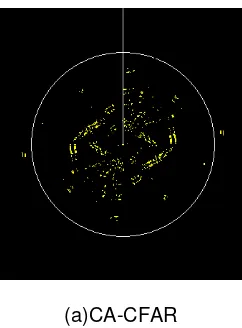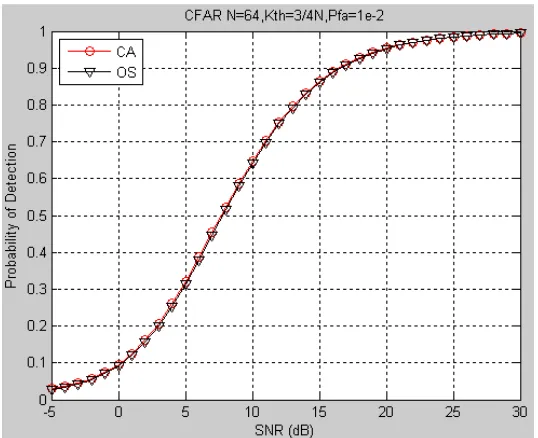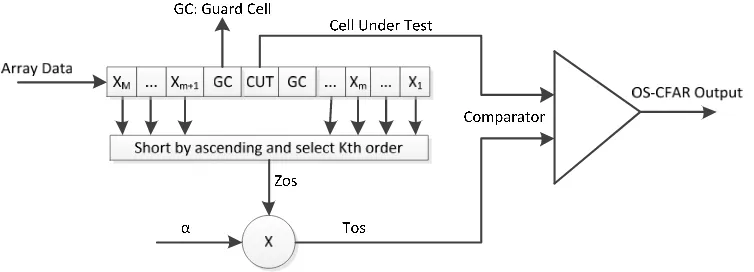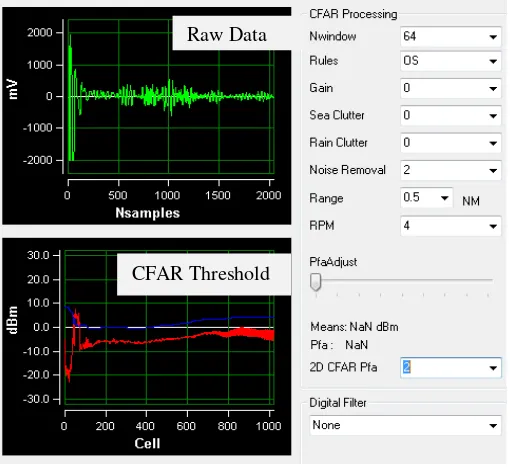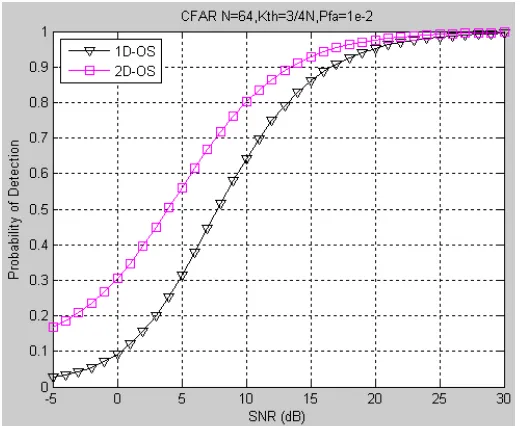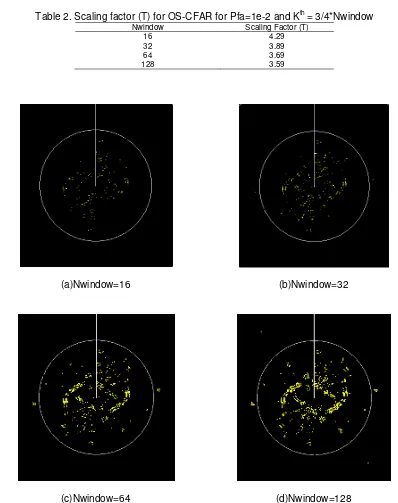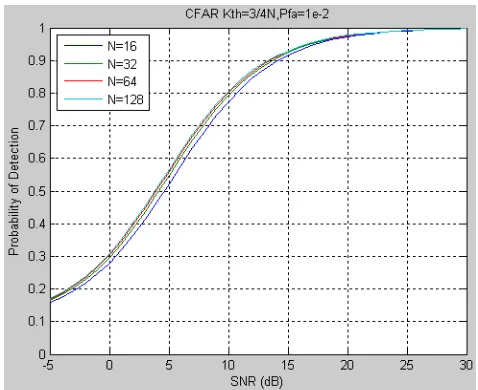DOI: 10.12928/TELKOMNIKA.v13i2.1189 624
Object Detector on Coastal Surveillance Radar Using
Two-Dimensional Order-Statistic Constant-False Alarm
Rate Algoritm
Dayat Kurniawan*, Purwoko Adhi, Arief Suryadi Satyawan, Iqbal Syamsu, Teguh Praludi
Research Center For Electronics and Telecommunication, Indonesian Institute of Science Kampus LIPI, Jl. Sangkuriang, GD. 20, Bandung 40135, Indonesia
*Corresponding author, e-mail: [email protected]
Abstract
This paper describes the development of radar object detection using two dimensional constant false alarm rate (2D-CFAR). Objective of this development is to minimize noise detection if compared with the previous algorithm that uses one dimensional constant false alarm rate (1D-CFAR) algorithm such as order-statistic (OS) CFAR, cell-averaging (CA) CFAR, AND logic (AND) CFAR and variability index (VI) CFAR where has been implemented on coastal surveillance radar. The optimum detection result in coastal surveillance radar testing when Pfa set to 1e-2, Kth set to 3/4*Nwindow and Guard Cell set to 0. Principle of 2D-CFAR algorithm is combining of two CFAR algorithms for each array data of azimuth and range. Order statistic (OS) CFAR algoritm is implemented on this 2D-CFAR by fusion rule of AND logic.The algorithm of 2D-CFAR is developed using Microsoft Visual C++ 2008 and the output of 2D-CFAR is plotted on PPI scope radar using GDI+ library. The result of 2D-CFAR development shows that 2D-CFAR can minimize noise detected if compared with 1D-CFAR with the same parameter of CFAR. Best performance of 2D-CFAR in object detection when Nwindow set to 128. The time of software processing of 2D-2D-CFAR is about two times longer than the 1D-CFAR.
Keywords: Object Detection, Noise Environment, OS-CFAR, 2D-CFAR
1. Introduction
Object or target detection in noise environment is very important problem in radar system. One technique to detect of object in noise environment is using constant false alarm rate (CFAR). This detection refers to a common form of adaptive algorithm used in radar systems to detect target returns against a background of noise, clutter and interference [1]. Cell average (CA) and order statistic (OS) CFAR has been implemented on coastal surveillance radar where has been tested in Tanjung Pasir Beach located in Banten Province, Indonesia and the result as shown on Figure 1.
(a)CA-CFAR (b)OS-CFAR
Figure 2. Performance detection of CA and OS CFAR
Two-dimensional constant-false alarm rate (2D-CFAR) will be developed to minimize noise detected rather than using one dimensional CFAR. Principle of two dimensional CFAR is combining of two cfar algorithm [10] to compare cell under test with array data of azimuth bin cell and array data of range bin cell as shown in Figure 3. OS-CFAR will be implemented and tested on this development of 2D-CFAR. It is chosen because it has good performance on non homogeneous environment and for multiple targets. The block diagram of OS-CFAR is as shown on Figure 4.
Figure 4. The Block diagram of the OS-CFAR algoritm.
The performance detection of OS-CFAR depending on select Kth which Kth = 3/4*N is the optimum value [11] and probability of false alarm (Pfa) value. The Kth value is estimated to be the means of clutter [12]. Scaling factor (Tos) calculated by following formula [8],[9],[13] :
1 ! !
This paper focus on the development of 2D-CFAR based on combine of two OS-CFAR algorithm. 2D OS-CFAR detector algorithm was developed using Microsoft Visual Studio C++ 2008.
2. Research Method
The 2D-CFAR implemented by combines of two OS-CFAR algoritm as shown on Figure 5. First step is calculate OS-CAFR for azimuth and then calculate OS-CFAR for range with output of each step is convert into binary number which logic 1 represent as object and logic 0 represent as noise. Each ouput from OS-CFAR-Azimuth and OS-CFAR-Range will be compared using AND logic rule to get output of 2D-CFAR as shown on Table 1. Base on optimum setting of previous experiment of coastal surveillance radar, so setting parameter of each OS-CFAR is Pfa=1e-2, Nwindow=64, Kth=3/4*Nwindow, array of bin cell of range=1024 and array of bin cell of azimuth=360.
OS-CFAR-Azimuth OS-CFAR-Range Ouput 2D-CFAR Description
0 0 0 Noise
0 1 0 Noise
1 0 0 Noise
1 1 1 Object or target
Figure 6. Collect data of array bin cell range and azimuth
Figure 7. Parameter Setting OS-CFAR Raw Data
3. Results and Analysis
Simulation for 2D OS-CFAR from raw data coastal surveillance radar is done by configuring CFAR parameter on window software as shown on Figure 7. First simulation is one dimensional CFAR using OS algorithm for range bin cell and then two dimensional CFAR with parameter setting is radial distance set to 0.5NM, sliding window set to 64, probability of false alarm set to 1e-2. Figure 8(a) show the result of one dimension CFAR where PPI scope show many clutter or noise in there. Figure 8(b) show the result of two dimensional CFAR where PPI scope show reduction of clutter or noise in the same region of Figure 8(a). Figure 9 show detection performance of 1D OS-CFAR and 2D OS-CFAR where 2D OS-CFAR has better detection rather than 1D OS-CFAR for same SNR value. Figure 10 show different performance of 2D-CFAR with difference Nwindow setting where radial distance set to 1 nautical mile and probability of false alarm set to 1e-2.
(a)one dimensional CFAR (b)two dimensional CFAR
Figure 8. Minimize noise detected CFAR
Figure 9. Performance detection of 1D-OS and 2D-OS CFAR
Better performance of 2D-CFAR achived when Nwindow set to 128 as shown on Figure 11. Object or target detected can be seen clearly from the other its because scaling factor (T) is
(a)Nwindow=16 (b)Nwindow=32
(c)Nwindow=64 (d)Nwindow=128
Figure 10. 2D-CFAR performance with difference Nwindow
of 2D-CFAR is more longger than rotation speed of antenna so Nwindow CFAR must be decrease to reduction time processing but it’s will decrease perform of radar object detection too.
Figure 11. Difference performance 2D-OS-CFAR base on number of sliding window
Table 3. The time of program processing of 1D-CFAR vs 2D-CFAR
Nwindow 1D-CFAR (ms) 2D-CFAR (ms)
Software development of 2D-CFAR works as expected. Ouput of 2D-CFAR and 1D-CFAR has different performance on object or target detection in noise inveronment radar system. Performance of object detection of 2D-CFAR is better when Nwindow set to 128. The time of software processing of 2D-CFAR is about two times longer than the 1D-CFAR. In the future optimize of algorithm to reduce software processing time is needed.
Acknowledgement
Thanks to Research Center for Electronics and Telecommunications-Indonesian Institute of Science, Bandung for all the support and coorperation.
References
[1] Yuhua Q, Huili G, Ting L. A new CFAR Detector based on Automatic Censoring Cell Averaging and Cell Averaging. TELKOMNIKA Indonesian Journal of Electrical Engineering. 2012; 11(6): 3298-3303. [2] Sung WH, Dong SH. Performance Analysis of an Environmental Adaptive CFAR Detector. 2014: 1-7.
http://dx.doi.org/10.1155/2014/615704.
[3] H Mansouri, M Hamadouche, F Youcef E. Influence of Ordered and Weighted Analysis Windows on Detection in a CFAR Radar. International Journal of Circuit, System and Signal Processing. 2014; 8: 109-115.
[4] Mohamed B, Faouzi S. Performance Comparison of Some CFAR Detectors in Homogenous and Non-Homogeneous Clutter. IEEE International Conference on Signal and Image Precessing Applications(ICSIPA). 2013: 101-105.
157–175.
[12] Xiang S, Ran T, Xia B. A Fast Order Methode on OS-CFAR Detector in SAR Image. 2009: 725-728. http://dx.doi.org/10.1109/APSAR.2009.5374218.
[13] Rohling H. Radar CFAR Thresholding in Clutter and Multiple Target Situations. IEEE Transactions on Aerospace and Electronic Systems. 1983; 19: 608–621.
[14] Ajay KY, Laxmi K. Moving Target Detection Using VI-CFAR Algorithm on Matlab Platform.
International Journal of Advanced Research in Computer Science and Software Engineering. 2013; 3(12): 915-918.
[15] H Mansouri, M Hamadouche, F Youcef E. Influence of Ordered and Weighted Analysis Windows on Detection in a CFAR Radar. International Journal of Circuits Systems and Signal Processing. 2014; 8: 109-115.
[16] Waleed KAA, Najim AU. Evaluation of AND-CFAR and OR-CFAR Processor under Different Clutter Models. Engineering & Technology Journal. 2013; 31(5): 964-975.
[17] P Paprocki. Impact of Internal and External Interferences on the Performance of a FMCW Radar. International Journal on Marine Navigation and Safety of Sea Transportation. 2011; 5(3): 325-328. [18] Ryszard W. Experimental Evaluation of The Constant False Alarm Rate (CFAR) Algorithms used in
